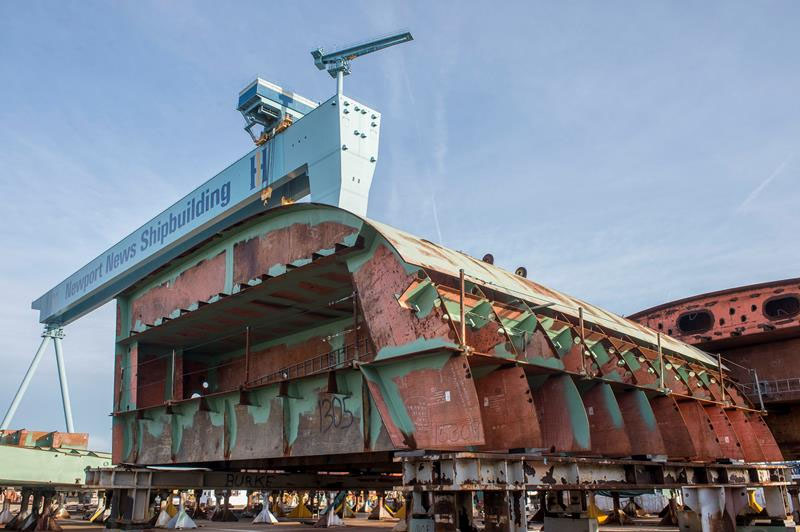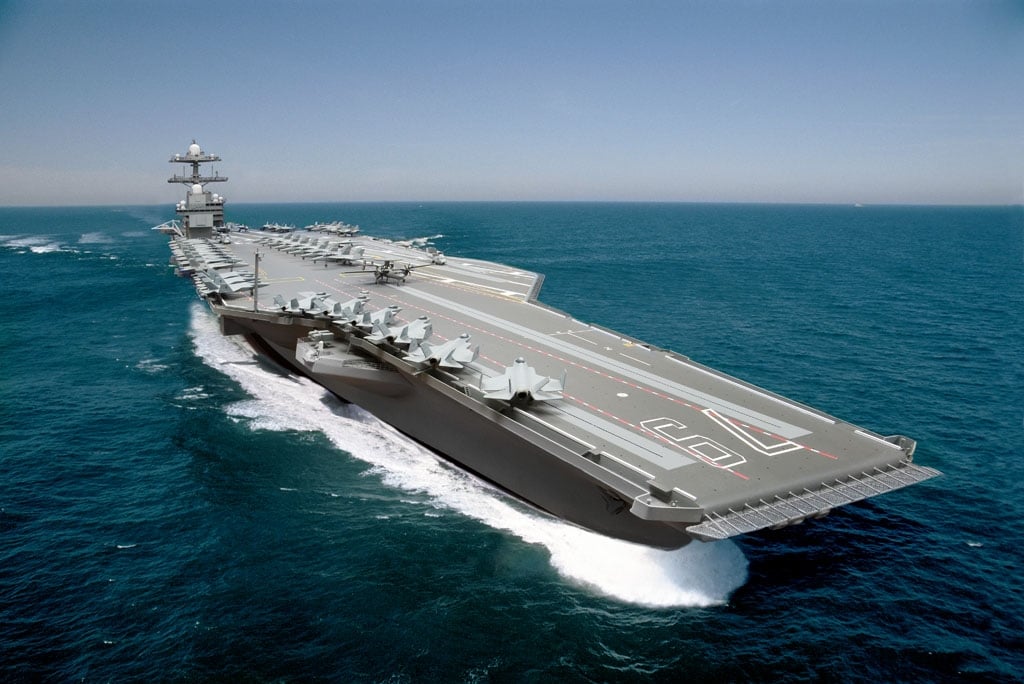
Lawmakers are considering lowering the congressional cost cap for the second Ford-class aircraft carrier, John F. Kennedy (CVN-79), to a dollar figure the Navy says it cannot commit to.
The Senate Armed Services Committee proposed lowering the cost cap by $100 million in its version of the National Defense Authorization Act for Fiscal Year 2016. The committee did so based on a new, lower “total ship estimate” the Navy submitted in its budget request documents in February – $11.348 billion, compared to the current congressional cost cap of $11.498 billion.
The Senate committee chose to lower its cost cap by $100 million rather than the full $150 million to hold the Navy accountable for some cost reduction while still leaving some margin for the second-in-class ship, USNI News understands.
The Navy, however, will only commit to meet the higher figure, not the lower estimate from February, Naval Sea Systems Command officials told USNI News.
The program office requested the full $11.498 billion in last year’s FY 2015 budget submission, NAVSEA spokeswoman Colleen O’Rourke said. This year, however, “the FY 2016 president’s budget request reflects $80.5 million in congressional reductions.
An additional $69.8 million reduction was made late in the budget process, bringing the total reduction to $150.3 million,” she said, though the program office did not confirm whether the $69.8 million reduction came from lawmakers, the Pentagon or the Navy.
“Due to the reductions to the CVN-79 budget outlined above, the budget controls established by the Department for the president’s budget Fiscal Year 2016 submission were required to be $11,348 million,” she said.
Despite the requirement to submit the lower figure, “the program manager’s estimate for the CVN-79 is $11,498 million,” O’Rourke said.
“The Navy is committed to maintaining the cost of CVN-79 within the congressional cost cap of $11,498 million.”
And yet, last week the House and Senate armed services committees began a conference committee to work out the differences between their two versions of the defense policy bill. The Senate’s version would lower the cost cap, and the House’s version was silent on the issue. If the final version of the bill contains this provision, the Navy would have to scramble to avoid breaching the cost cap.
On June 2, the White House wrote to the Senate Armed Services Committee with a list of concerns about its bill, including a paragraph on the CVN-79 cost cap.
“The Administration strongly objects to section 111, which would reduce the cost limitation baseline for CVN 79 and subsequent FORD-class carriers to $11.398 billion,” reads the Statement of Administration Policy.
“A $100 million reduction would degrade the capabilities of CVN 79 and follow-on ships or increase the risk of a breach of the cap. The current cost cap represents a significant reduction from CVN 78 and will be challenging to achieve. Further reductions may impact the delivery of integral warfighting capability. The Department has worked with the shipbuilder and other system providers to revamp the construction process for CVN 79 to avoid the cost increases experienced with construction of CVN 78.”

Program Executive Officer for Aircraft Carriers Rear Adm. Tom Moore told reporters at the Pentagon on June 15 that the recent construction contract for CVN-79 is “probably the best CVN fixed-price contract we’ve ever had with [Newport News Shipbuilding] in terms of the target fee in the contract, the steepness of the share lines, the ceiling price in the contract – all reflective of the fact that the shipbuilder and us have a very solid understanding of where we are in the ship and the cost we’re able to take out.”
Moore added that the Navy would save a billion dollars by reducing the man hours needed to build the ship to about 44 million – an 18-percent reduction compared to CVN-78. The Navy beginning in FY 2017 will also create a research and development fund to pursue cost-saving ideas at the shipyard.
It is unclear what number the program office will submit in the FY 2017 budget request, which is being worked on now. That “submission to Congress is dependent on decisions within the Department that are not yet final and on the outcome of the budget deliberation process for the FY 2016 request currently on the Hill,” O’Rourke added.
The cost of Kennedy has been a topic of conversation on the Hill recently. SASC chairman Sen. John McCain (R-Ariz.) expressed his concern after the Pentagon’s Cost Assessment and Program Evaluation (CAPE) office identified its estimate for the ship as $11.868 billion – $370 million above the congressional cost cap and $520 million above the estimate in the FY 2016 budget submission.
“Accountability must be restored to the Ford-class aircraft carrier program,” McCain said in a statement after Bloomberg News first reported on the CAPE estimate.
“Our nation simply cannot afford these kinds of cost overruns amid rising global threats and fiscal challenges. If this new cost estimate is accurate, I expect the Pentagon to promptly notify the Senate Armed Services Committee who is responsible for this cost overrun and what will be done to hold those individuals accountable.”
“I remain concerned that the USS Gerald R. Ford (CVN-78) design is still not stable given its dependence on completing design and development of major systems like the Advanced Arresting Gear,” he continued.
“Effectively, the Navy is concurrently refining CVN-78 design and constructing the ship while getting ready to award the contract for CVN-79. These issues with CVN-78 raise questions about whether now is the time to award this contract for CVN-79. This latest news report does not give me confidence that the Department of Defense understands the risk and cost of CVN-79, which they will be passing along to American taxpayers.”
There is usually some discrepancy between CAPE estimates and the figures coming out of the program office. The Congressional Budget Office estimates the ship will cost about 8 percent more than the Navy’s estimate.
The program office’s estimate for CVN-79 has changed dramatically over time. In FY 2008 the program said it could build the ship for $9.191 billion. In FY 2014 it submitted a $11.338-billion figure, followed by the $11.498-billion estimate in FY 2015 and then this year’s $11.348-billion figure, according to a Congressional Research Service report.





